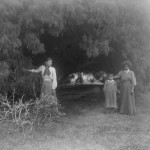Margaret River
The town of Margaret River is firmly situated in the South West Boojarah region in Noongar booja (country). Noongar have lived in this part of booja since the Nyittiny – creation times.
To Noongar people, the Margaret river is known as Wooditchup, named after the magic man, Wooditch, who created the river in the Nyitting or the Dreaming. [i]
Noongar people have a long and continuing connection to this area. Devil’s Lair cave, south of Margaret River, is one of the earliest sites of human occupation in Australia. Evidence of Noongar existence dates back about 48,000 years. Excavations have uncovered stone artefacts, animal bones, hearths, bone artefacts and human remains. Some of the earliest ornaments in Australia were found here, including three ground-bone beads and what may be a bone pendant.[ii]
A long time ago, two young lovers used to meet in a cave south of what is now Gracetown. The woman, named Mittan, was promised to King Bunyitch and when he found out, he had her lover, Nobel killed. Mittan was so distressed she drowned herself in the cave. Noongars call the cave ‘Meekadarabee‘, the bathing place of the moon. Sometimes, if you come to the cave when the moon is bright, you can see her hair and the spaces where her eyes would be, reflected in the water and you may hear her crying.[iii]
Margaret River first appeared on a map in 1839. Early European settler, John Bussell is thought to have named the south-west river in honour of Margaret Wyche, a friend in England. [iv]
In 1850, the first Europeans came to live in the area. Alfred and Ellen Bussell established their farm ‘Ellensbrook’ at a traditional Noongar camping area called Mokidup.[v]
Noongar people continued to live in the area and some, including Nannup, Nilgi, and Sam Isaacs worked for the Bussell family.[vi]
Whadjuck/Ballardong Nyungar, Professor Leonard Collard, wrote that Noongar people’s work for the Bussells included ‘language translation, flora and fauna identification, farm labouring, herding sheep and cattle, milking, making butter and cheese, whaling, fishing, bullock driving, horse training, timber clearing, mail delivery, childcare and lumbering at local timber mills’.[vii]
On 1st December 1876, Sam Isaacs and the Bussells’ daughter, Grace, became heroes when they rescued passengers from the ship Georgette after it ran aground off Margaret River. Both Sam and Grace rode their horses into the water, grabbing as many survivors as they could. With the very rough seas, the rescue took four hours. [viii]
In recognition of his services, Sam Isaacs received a Bronze medal from the Royal Humane Society. Much later, in 1897, he received his reward – 100 acres of land on the Margaret River at Sussex Location 243.
The Isaacs family worked the land, known as Fernbrook, until the 1930s when it became difficult to make a living from a small farm during the Depression. They sold up and moved to Margaret River town where it was easier to get work and to send the children to school.[ix]
The Bussells first farm became a mission in 1898 and was known as Ellensbrook Farm Home. The mission was run by Miss Edith Bussell and housed up to ten Aboriginal children, as well as providing a temporary home for adults.
The children did mainly farm and domestic work and received only a basic education. When they were old enough, the girls went out to work as domestics and the boys worked for local farmers.[x]
Following cuts in government subsidies to missions, Ellensbrook was closed in 1917.
With so many men and women away during World War II, there was plenty of work for Noongar people. Men were employed in seasonal contract work for the wheat and sheep industry – shearing, clearing land and fencing. Women were mainly employed in domestic work. [xi]
Noongar people continued to live in family groups and to practice traditional ways, whilst also working for local farmers. Noongars were in demand as shearers and working in the potato fields, but competition from migrants and other white workers, together with the downturn in the wool and pastoral industries, meant that work was scarce at times.[xii]
The Wardan Centre on Injidup Springs Road, Yallingup, was opened in 2001 as a place where local Wardandi Noongars can pass on and maintain cultural knowledge. The centre also promotes education and understanding of Noongar culture in the wider community.[xiii]
The South West Boojarah claim for Native Title was made in September, 2006.
References
[i] 'Margaret River Heritage Trail', Heritage Council, pp.3-4
[ii] Dortch, C. 1979. Devil's Lair, an Example of Prolonged Cave Use in South-Western Australia. World Archaeology 10(3):258-279.
[iii] B.Webb, Personal Communication on 4.11.10.
[iv] Landgate, http://www.landgate.wa.gov.au/corporate.nsf/web/History+of+Country+Town+Names downloaded 13.10.10
[v] L. Collard, 'An Analysis of Nyungar Influence in South West Western Australia', MA thesis, 1996, p.80
[vi] O. Richards, 'Conservation Study Ellensbrook Margaret River W.A.', National Trust of Australia (WA), 1992
[vii] L. Collard, 'An Analysis of Nyungar Influence in South West Western Australia', MA thesis, 1996, p.80
[viii] Webb, George, Nunyahboogera,(self published), Busselton, Western Australia, p.46,47; Also see ABC website: http://www.abc.net.au/backyard/shipwrecks/wa/georgette.htm
[ix] L. Collard, 'A Nyungar Interpretation of Ellensbrook and Wonnerup Homesteads', Report for the National Trust of Australia (WA), 1994, pp.22, 88; Webb, George, Nunyahboogera, p.48
[x] A. Haebich, For Their Own Good: Aborigines and Government in the SouthWest of Western Australia 1900-1940. University of Western Australia Press, 1992, pp.7-9, 67, 70, 167
[xi] S.Hodson Nyungars and Work, Aboriginal experiences in the Rural Economy of the Great Southern Region of Western Australia. 1993, Vol:17 pp-73- p94. Annual Report of the Commissioner of Native Affairs, 1944, pp.5, 11, 22-23
[xii] Annual Report of the Commissioner of Native Welfare, 1960, p.37
[xiii] http://www.wardan.com.au/pages/intro.html Viewed 8 March 2010. Permission to share information given by Bill Webb, 30 August 2010







